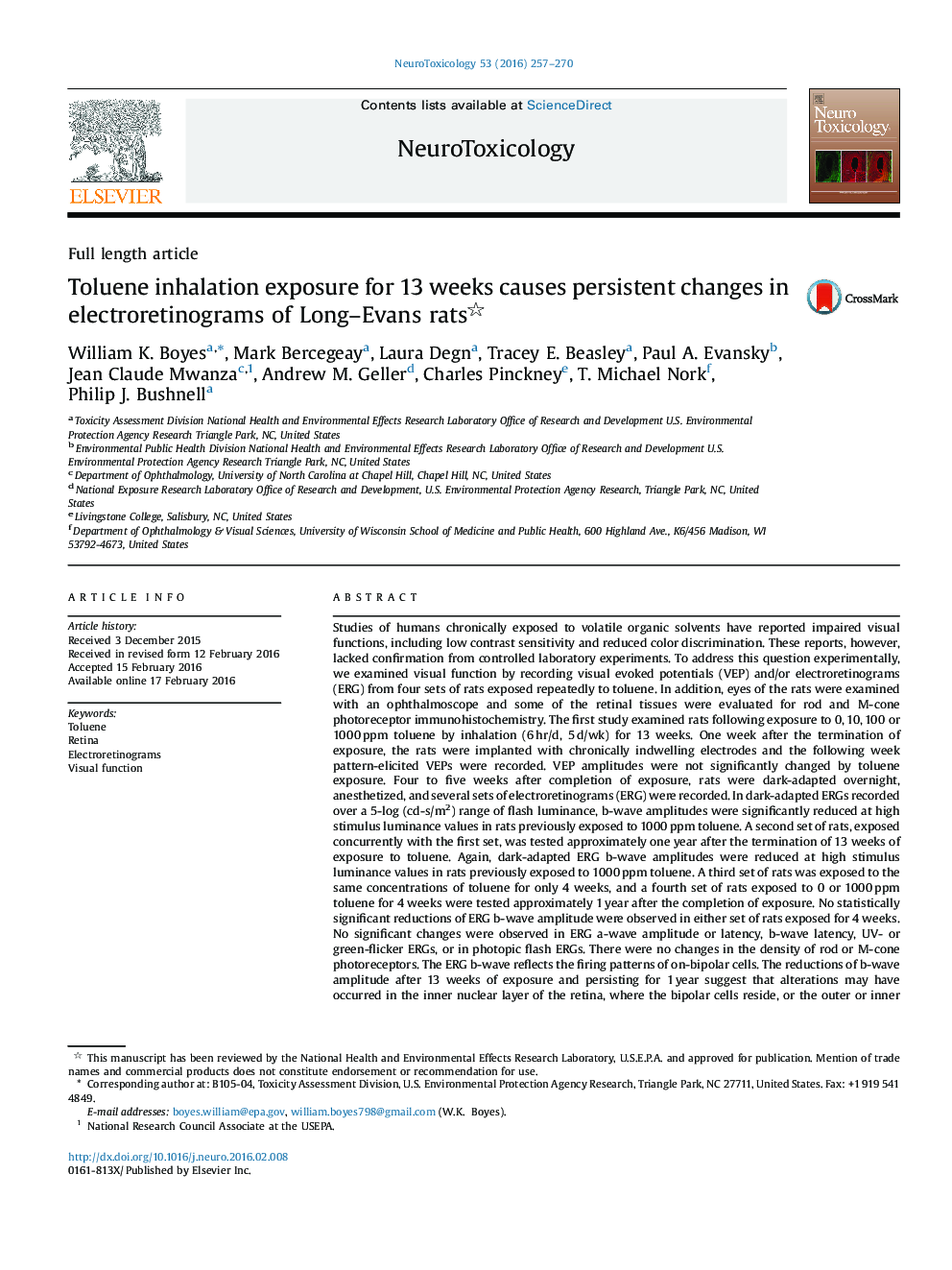| Article ID | Journal | Published Year | Pages | File Type |
|---|---|---|---|---|
| 5854810 | NeuroToxicology | 2016 | 14 Pages |
â¢Rats were exposed to either control air or one of three concentrations of toluene vapors for either 4 or 13 weeks and their visual function was measured either shortly after termination of exposure or approximately 1 year afterward.â¢Rats exposed to 1000 ppm toluene for 13 showed a reduction of the electroretinogram b-wave amplitude at higher flash illumination values when tested shortly after termination of exposure and also one year later.â¢Rats exposed to lower concentrations (10 or 100 ppm) or for a shorter duration (4 weeks) did not show significant ERG changes.â¢The results confirm previous observational studies of persistent visual deficits in workers exposed to organic solvent vapors in a controlled experimental setting that avoids many of the potential confounding and interpretational factors associated with cross-sectional occupational studies.â¢When expressed as cumulative exposure (ppm-years), the deficits of visual function observed in rats occurred at levels of exposure lower than those reported to impair visual function in occupational studies.
Studies of humans chronically exposed to volatile organic solvents have reported impaired visual functions, including low contrast sensitivity and reduced color discrimination. These reports, however, lacked confirmation from controlled laboratory experiments. To address this question experimentally, we examined visual function by recording visual evoked potentials (VEP) and/or electroretinograms (ERG) from four sets of rats exposed repeatedly to toluene. In addition, eyes of the rats were examined with an ophthalmoscope and some of the retinal tissues were evaluated for rod and M-cone photoreceptor immunohistochemistry. The first study examined rats following exposure to 0, 10, 100 or 1000Â ppm toluene by inhalation (6Â hr/d, 5Â d/wk) for 13 weeks. One week after the termination of exposure, the rats were implanted with chronically indwelling electrodes and the following week pattern-elicited VEPs were recorded. VEP amplitudes were not significantly changed by toluene exposure. Four to five weeks after completion of exposure, rats were dark-adapted overnight, anesthetized, and several sets of electroretinograms (ERG) were recorded. In dark-adapted ERGs recorded over a 5-log (cd-s/m2) range of flash luminance, b-wave amplitudes were significantly reduced at high stimulus luminance values in rats previously exposed to 1000Â ppm toluene. A second set of rats, exposed concurrently with the first set, was tested approximately one year after the termination of 13 weeks of exposure to toluene. Again, dark-adapted ERG b-wave amplitudes were reduced at high stimulus luminance values in rats previously exposed to 1000Â ppm toluene. A third set of rats was exposed to the same concentrations of toluene for only 4 weeks, and a fourth set of rats exposed to 0 or 1000Â ppm toluene for 4 weeks were tested approximately 1Â year after the completion of exposure. No statistically significant reductions of ERG b-wave amplitude were observed in either set of rats exposed for 4 weeks. No significant changes were observed in ERG a-wave amplitude or latency, b-wave latency, UV- or green-flicker ERGs, or in photopic flash ERGs. There were no changes in the density of rod or M-cone photoreceptors. The ERG b-wave reflects the firing patterns of on-bipolar cells. The reductions of b-wave amplitude after 13 weeks of exposure and persisting for 1Â year suggest that alterations may have occurred in the inner nuclear layer of the retina, where the bipolar cells reside, or the outer or inner plexiform layers where the bipolar cells make synaptic connections. These data provide experimental evidence that repeated exposure to toluene may lead to subtle persistent changes in visual function. The fact that toluene affected ERGs, but not VEPs, suggests that elements in the rat retina may be more sensitive to organic solvent exposure than the rat visual cortex.
